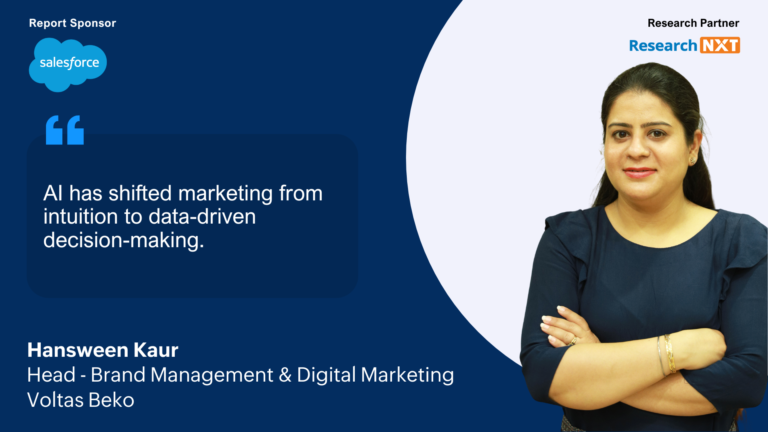
Transforming Skincare: SkinQ’s AI-Powered Vision and Strategic Marketing Insights
For too long, skincare has overlooked the unique needs of brown and darker skin tones. Meera Iyer, Co-founder and CEO of SkinQ, is on a mission to change that. In this in-depth interview with Research NXT, Meera reveals how SkinQ is using AI and cutting-edge science to develop personalised skincare solutions. From their revolutionary AI Mirror to dermatologist-backed formulations, SkinQ is redefining the beauty landscape and empowering individuals to achieve healthy, radiant skin. Meera also delves into the challenges of positioning a premium skincare brand in a crowded market, the evolving role of AI in modern marketing, and strategies for harnessing AI to create meaningful impact.
Key Highlights from the Interview
- SkinQ’s Mission and Innovation: SkinQ addresses unique skin challenges for brown and darker skin tones, offering clinically proven, dermatologist-formulated solutions that simplify skincare. The AI Mirror tool enhances customer engagement by providing tailored product recommendations based on accurate skin analysis.
- Marketing in a Saturated Market: SkinQ faces the challenge of competing with over 1 lakh beauty brands in India. Strategies include leveraging prescriptions from dermatologists, promoting clinical efficacy through Meta and Google, and encouraging referrals.
- AI’s Role in Skincare: While AI tools like the AI Mirror help identify skin concerns, SkinQ relies on human expertise for personalised recommendations, especially for complex skin issues. The brand recognises the evolving potential of AI in automating tasks and enhancing customer experience but acknowledges its current limitations.
- Evolution of Marketing Technology: Marketing has transformed significantly over the past decade, with platforms like Google and Meta becoming more AI-driven. Advanced analytics tools now provide seamless insights, enabling marketers to focus on strategic decision-making rather than manual data collation.
- Recommendations for AI Adoption: Businesses should critically evaluate AI’s relevance to their operations, the quality of data powering AI solutions, and their alignment with specific use cases. Clean data, contextual relevance, and clear objectives are key to unlocking AI’s full potential.
“While AI is evolving, it hasn't yet reached the level where it can effectively replace the personalised consultations we provide, which are highly case-specific.”
Could you start by sharing a brief overview of SkinQ? We want to understand the story behind the brand, its mission, and the core values that drive its vision in the skincare industry.
Meera: SkinQ is a derma-cosmetic brand founded by Dr. Chytra Anand, a renowned dermatologist who has made significant contributions to the global dermatology community. Dr Anand represents India at the World Anti-Aging Congress and serves on the technical committee of the Skin of Color Society, an international organisation dedicated to understanding and treating skin issues specific to brown and darker skin tones.
Recognising the need for customised skincare solutions tailored to brown skin, Dr Anand identified gaps in the market. Unlike white or lighter skin tones, brown skin has much more melanin, which offers protective benefits against irritants and UV rays but also presents unique cosmetic challenges such as uneven skin tone, pigmentation, and prolonged post-inflammatory marks from wounds or acne. While melanin acts as a natural shield, its overproduction can lead to issues like tanning and patchiness, which are often misunderstood or inadequately addressed by brands that replicate formulations designed for lighter skin tones.
Dr Anand, leveraging her expertise as a dermatologist and formulation specialist, decided to address these challenges. She developed SkinQ to provide evidence-based, clinically proven skincare solutions specifically for brown and darker skin. SkinQ’s formulations are designed to simplify skincare by eliminating the need to layer multiple products. Each product is a multi-active solution addressing the root cause, side effects, and symptoms of skin issues, while simultaneously strengthening the skin barrier.
To ensure efficacy, Dr. Anand conducted clinical trials on a significant portion of the product range, with results placing SkinQ products in the 99th percentile globally for effectiveness. SkinQ focuses on treatment-oriented solutions for common concerns like pigmentation, acne, skin sensitivity, and dryness, while also offering daily essentials like sunscreen, moisturisers, and cleansers.
Built on the philosophy of “a dermatologist in a bottle,” SkinQ embodies Dr. Anand’s mission to make expert dermatological care accessible to all. It offers superior, science-backed products tailored to the specific needs of individuals with brown and darker skin tones, addressing widespread issues with evidence-based, high-efficacy solutions.
Given your products’ technical and medically nuanced nature, would you say SkinQ is primarily prescription-driven, or can consumers independently determine the right product for their needs without professional consultation?
Meera: SkinQ’s products are OTC (over-the-counter) with near prescription-level efficacy and are accessible through marketplaces and our website. To assist customers in choosing the right product, we’ve developed an AI-powered face analysis tool. This tool identifies skin issues and recommends suitable products based on a database of Indian faces, ensuring accuracy for brown skin tones.
Many customers lack understanding of their skin concerns or fall prey to misinformation from trends and influencers. For instance, someone with oily, acne-prone skin might use unsuitable products like snail mucin, worsening their condition. Our AI tool addresses this by providing tailored recommendations for individual needs and skin types, leveraging insights from clinics and dermatologist-verified data.
While prescriptions account for about 40% of our business, especially in regions like the US, GCC, and Nepal, where SkinQ is well-received by dermatologists, the remaining comes from B2B and B2C sales. Customers can either rely on our guidance via social media or WhatsApp inquiries or make informed choices independently through the detailed information available on our website. This dual approach ensures accessibility and effectiveness for all our users.
Read More
As you mentioned, you’re targeting a significant portion of the global population, many of whom may search for products like fairness creams that don’t align directly with SkinQ’s offerings. How do you approach targeting across multiple channels in this context? How is your marketing funnel designed, and what role does technology play in enabling personalisation for the specific segment you’re focusing on?
Meera: The challenges we’re tackling at SkinQ are not niche—problems like pigmentation and acne are widespread. However, the real challenge lies in standing out in a saturated market with over a lakh beauty and personal care brands on platforms like Nykaa and Amazon. Cutting through this clutter and effectively communicating SkinQ’s unique differentiation and clinical superiority is critical, especially given our position as a premium brand.
Our marketing strategy involves multiple channels. First, we gain customers through prescriptions from dermatologists. These customers often return to purchase online, even after their doctor visits have ended. Second, we use digital platforms like Meta and Google to highlight clinical trial results and position Dr. Chytra as the trusted face of the brand, bringing credibility and a dermatologist’s expertise to the forefront. Lastly, referrals from satisfied customers form a growing, organic channel. While relatively small, this channel holds great potential, and we are exploring ways to encourage more word-of-mouth recommendations.
As a premium brand, our solutions are not inexpensive, which reflects our commitment to quality. For example, our Vitamin C serum uses Grade 1 L-Ascorbic Acid of 99.8% purity, a highly unstable but effective form of vitamin C, sourced at a significant cost and stabilised using proprietary techniques. This serum is clinically proven to prevent 91% oxidative damage—almost matching the gold standard of pure 100% Vitamin C solution at 92%. In contrast, many brands use ethyl ascorbic acid, a cheaper, more stable alternative that lacks the same efficacy, yet they claim similar benefits.
The lack of regulation in the personal care industry exacerbates the problem. Unlike food brands, personal care companies are not required to disclose detailed ingredient information or substantiate claims. This allows low-quality products to make unverified promises, diluting the market and misleading customers. Competing in such a cluttered and under-regulated category, while maintaining our commitment to quality and efficacy, remains a significant challenge.
Many consumers may think ‘Vitamin C is Vitamin C’ without understanding the difference between L-Ascorbic Acid and Ethyl Ascorbic Acid. How do you create awareness about your product’s superiority and the need for specialised formulations for brown skin? As someone experienced in marketing e-commerce brands, how has your approach evolved to cater to a niche yet impactful category like SkinQ?
Meera: Honestly, it’s challenging, and I’m still figuring it out—it’s very much a hit-and-miss process. The reality is, only a small fraction of people will give you the time to explain your product’s value, and even fewer will take the leap to invest in a brand that costs twice as much as others making similar claims. This is why referrals are a key area I’m focusing on. When someone trusted shares their experience, it creates a level of credibility that’s hard to replicate through ads or influencers.
For instance, when I speak to someone personally about SkinQ, they’re often intrigued enough to consider trying it. Scaling that same level of trust across entertainment-driven platforms is much harder and remains a work in progress. We’ve seen that using doctors as brand advocates adds credibility, but even here, many brands pay doctors to promote their products, which makes differentiation harder despite our unique positioning as a dermatologist-founded and formulated brand.
One strategy we’re exploring is consistently targeting a specific group and maintaining communication over time. Sometimes, persistence alone drives curiosity and brings people to our site. However, there’s still no magic formula, and I’m open to new ideas on how to effectively scale awareness and trust in SkinQ.
What motivates me deeply is seeing the real-life impact our products can have. I saw it firsthand when my daughter struggled with severe acne. It affected her confidence and happiness immensely, and despite visiting several dermatologists, nothing worked. When Dr Chytra prescribed a solution that included SkinQ, the results were transformative for her skin and overall self-esteem.
Personally, I’ve dealt with vitiligo for over 15 years, so I understand how skin issues can affect one’s quality of life. That’s why SkinQ’s mission resonates so strongly with me. Our goal is to positively impact the lives of at least 10 million people by providing solutions that not only treat their issues but strengthen and protect their skin over the long term.
These problems—acne, pigmentation, sensitivity—are incredibly common in people with our brown melanin rich skin. Reaching more individuals, helping them try SkinQ, and seeing real results would truly be a monumental achievement for us.
How are you integrating technology into your current marketing and sales approach? Specifically, how are you leveraging AI, such as the AI Mirror, within your marketing and sales funnel to enhance customer engagement and drive results?
Meera: Our implementation of technology in our current approach is quite limited, aside from the AI Mirror. Significant technology investments in a physical product company like ours typically come with scale. The reason we have the AI Mirror, unlike many competitors, is because Dr Chytra developed it for our clinics to assist other practising doctors. Since we already had this tool, we incorporated it into our consumer offerings.
Beyond that, technology is inherently embedded in any brand selling online today. We use platforms like Shopify for our website, and our marketing on Meta and Google is fundamentally AI-driven. For example, Google has shifted entirely to algorithm-based advertising, eliminating manual inputs. Meta still allows some manual interest-based targeting, but even there, options like Advantage Campaigns are completely AI-driven.
We did consider implementing an AI-powered chatbot for customer interaction. A company pitched us their solution, and we tested it by asking, “I have acne marks, what product should I use?” The chatbot, after scanning our website, recommended our Brightening Serum, which is an anti-pigmentation cream intended for individuals over 18 due to the strength of the active ingredients. However, acne issues also often affect younger individuals, such as teenagers around 15 years old. This recommendation would have been inappropriate and potentially harmful.
Moreover, skin treatment doesn’t work in isolation. It’s a holistic approach that considers other products the customer is using, their age, medical history, and any known sensitivities. For instance, some people cannot tolerate vitamin C, so we need to avoid recommending products containing it. Personalised consultation is crucial to ensure customers receive appropriate advice and avoid complications.
While AI is evolving, it hasn’t yet reached the level where it can effectively replace the personalised consultations we provide, which are highly case-specific. In categories like apparel or general fashion, AI chatbots may suffice, but in specialised fields like skincare treatment, we must exercise caution in automated recommendations to ensure customers achieve the desired results without adverse effects.
On the AI Mirror side, it seems you’ve already achieved a significant milestone by enabling face scanning and providing personalised recommendations. Could you elaborate on how it works?
Meera: Our AI Mirror is hosted on a separate platform that Dr. Chytra collaborated with, and we pay a small platform fee for its usage. Interestingly, while many people use the AI Mirror for skin analysis, we’ve noticed a trend where a significant number do it just for fun rather than with serious intent.
The more serious users—those genuinely interested in understanding their skin concerns—tend to engage better in one-on-one interactions. When we guide them personally, they appreciate the insights and find the process valuable. However, the same users often fail to engage meaningfully when nudged online.
A major challenge is that many users input incorrect details, such as fake names or numbers, even while performing the face scan. When we attempt to follow up with these users, over 90% of the contact information turns out to be invalid, limiting our ability to assist them further.
Based on your extensive experience in marketing across e-commerce and various other segments, how do you perceive the evolution of marketing technology and the integration of AI in marketing? What are your observations on its impact and progression, beyond just the skincare industry?
Meera: Two major channels for digital marketers today, Google and Meta, have evolved significantly over the past decade. Back in 2015, platforms like AdWords and Business Manager lacked creative-driven logic and were heavily manual. Over the years, tagging quality and data accuracy have improved dramatically, thanks to the vast data these platforms have collected. For instance, Google’s ability to identify user demographics or interests was once questionable, but today, their classifications have become much more precise.
However, this evolution hasn’t been without challenges. Privacy concerns and global regulations have led to the removal of several targeting groups on Meta and the phasing out of third-party cookies on Google, impacting the ability to track individual behaviour. These changes peaked during the pandemic when online activity surged but are now gradually diluting as privacy laws tighten.
Technology is now integral to every facet of online branding, from customer discovery to marketing automation and backend processes. Analytics, in particular, has transformed into the backbone of modern businesses. Tools like Maple Monk aggregate data from platforms like Shopify, Amazon, Nykaa, and Unicommerce into centralised dashboards, enabling actionable insights without the manual effort of logging into multiple systems.
The advancements in analytics tools today are remarkable compared to a decade ago. What once required painstaking manual work—like cohort analysis or day-level P&L tracking—can now be achieved with a few clicks. These innovations free up time for strategising and decision-making rather than data collection, making the process far more efficient and insightful. Technology has truly simplified operations and empowered marketers to focus on high-value activities, driven by data.
In industries like skincare and wellness, what AI trends do you believe will redefine customer engagement and product development in the next 3–5 years?
Meera: There are two areas I find particularly exciting when it comes to the future of AI in commerce and marketing. First, voice-led AI applications are an untapped opportunity. Imagine a scenario where a customer visits the SkinQ website and is greeted by a voice assistant that says, ‘Hi, I’m here to help! Would you like a facial analysis powered by AI?’ From there, the interaction could be entirely voice-driven—asking for age, discussing skin concerns, and recommending products—all while maintaining a conversational, human-like experience.
This would be similar to walking into a store and speaking with a salesperson who not only answers your queries but also offers personalised nudges that build trust and confidence in the purchase. For example, in a grocery store, when you ask if a product is fresh, the salesperson’s reassurance makes you feel more comfortable buying it. Translating that dynamic to a digital platform via voice-led AI would be revolutionary. Of course, challenges like understanding diverse accents and avoiding misinterpretations (e.g., confusing ‘salicylic acid serum’ with ‘salivate serum’) would need to be addressed, but the potential to replicate a real-world store experience digitally is incredibly exciting.
Second, AI is making strides in creative and marketing processes. Tools now exist that can generate ad copy, retention messages, and even video content with virtual presenters. From my experiments, these tools are great for enhancing and refining content but not as strong at generating ideas from scratch. For example, if you give them a concept, they can polish it beautifully, often surpassing what a human could achieve in terms of sharpness and embellishment. However, if you rely on them entirely for idea generation, the results are often subpar.
In video creation, some platforms allow you to produce product reviews or explainer videos with virtual presenters. However, a glaring gap is the lack of Indian faces in these tools, which limits their relevance in the Indian market. This presents a huge opportunity for local developers to create AI-driven tools with more culturally appropriate options, reducing the burden on video editors and expanding the possibilities for localised marketing.
Looking ahead, it’s clear that AI will continue to replace certain roles, especially at the junior level in areas like content creation, video production, and design. While current tools aren’t yet good enough to replace human creativity entirely, they are improving rapidly. In the next five years, it will be fascinating to see how AI transforms the workforce and how companies adapt to these changes.
Lastly, as this conversation contributes to a report on AI adoption, what insights or recommendations would you like to see highlighted to guide businesses and leaders in leveraging AI effectively?
Meera: Here are three key considerations for businesses exploring AI implementation:
- Understand the Real Value of AI: Today, AI is often a buzzword thrown around loosely, attracting both interest and investment. However, not all “AI” solutions are genuinely leveraging the technology. It’s crucial to evaluate if AI is truly being used in a meaningful way and whether it has relevant use cases for your business. Simply adopting AI for the sake of it, without understanding its applications, can lead to wasted resources.
- Evaluate the Data Powering the AI: The effectiveness of any AI system depends on the quality and legitimacy of the data it is trained on. AI can provide information but doesn’t inherently assess the accuracy of that information. For example, if you search for the best form of vitamin C, you’ll find conflicting answers—some driven by marketing claims, others supported by scientific research. AI systems need to be built on clean, reliable, and contextually appropriate data. A case in point is the SkinQ AI mirror, which is more accurate because it is trained on Indian faces rather than relying on foreign datasets. The foundation of the AI determines the reliability of its outputs.
- Align AI to Your Specific Use Case: AI solutions should be tailored to address your specific business needs. For instance, while an AI chatbot might work well for certain industries, it may fall short for more specialised use cases that require deeper contextual understanding—like recommending skin treatments based on age, current product usage, and skin history. Ensure the AI solution you choose is fit for purpose and doesn’t require extensive post-deployment adjustments to align with your business requirements.
In summary, successful AI adoption requires clarity about its relevance, scrutiny of the data powering it, and a strong alignment with your specific business objectives.






